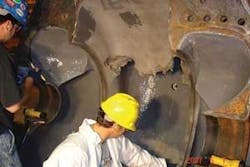Addressing Pump Corrosion and Erosion
by Robert L. Matthews
What made the wear on the pump, impeller, suction side plate, or nozzle – corrosion or erosion? Often, it's both. Wear or loss of pump materials in general can easily contribute to the pump running off its BEP (best efficiency point) curves. Either can shorten the MTBF (mean time between failure) and make it hard to get to a true root cause. What most of us don't see when we address these issues is that maintenance, production and downtime cost together can make the original pump cost appear very small. When you look at all these costs, you look at total cost of ownership. As such, decision-making is now for the company, not the unit or department.
The first thing we do in most cases is look at what we're pumping to see the chemical capability of the process and effects on pump materials. These choices are usually made in the infancy stages of the original pump system selection/purchase. If the process is abrasive, there are considerations for wear resistant materials.
Real world applications for any pump system that result in change from the original design can be for several reasons. A few items that, if changed, will get the system in trouble, include: temperature, concentration of corrosiveness, concentration of abrasive material, velocity of material, inducing reactionary materials, running off the BEP, incorrect piping... the list goes on and on.
We have so many resources at our fingertips today, but have to determine where to start. Do we call the OEM or a local shop to help? We can call Hoboken, NJ's Sims Pump Valve Co. – or a similar provider – for a composite pump, casing or impeller. This is a good option in some cases. We can call Standard Alloys, of Port Arthur, TX, or Houston-based Best PumpWorks to redesign the impeller vanes and correct flow. We can repair the components with Belzona composites or protective coatings and extend the run life many times in some cases.
All these solutions are available when we educate our employees as to what's out there. For more detailed solutions, check out Texas A&M's International Pump Users Symposium on Feb. 23-26 in Houston or LSU's Gulf South Rotating Machinery Symposium (GSRMS) on March 16-18 in Baton Rouge.
Remember, some corrosion and erosion will always be difficult to avoid – but not all of it. We take great care to learn new ways to combat this safely. Why not educate our customers to take as much care and operate our equipment safely longer as well?
About the Author: Reliability manager for Houston-based Royal Purple Ltd., Bob Matthews has 35+ years of pump industry experience – from hands-on to supervision, in-plant maintenance management, consulting and training. He has taught advanced pump classes for Fortune 500 companies, universities, the Vibration Institute, ASME and FSA. Contact: www.royal-purple.net
